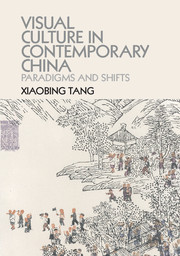Book contents
- Frontmatter
- Contents
- Acknowledgments
- A brief timeline of relevant events
- Introduction Toward a short history of visual culture in contemporary China
- Chapter 1 How was socialist visual culture created?
- Chapter 2 How was socialist visual culture created?
- Chapter 3 What do we see in New China cinema?
- Chapter 4 What does socialist visual experience mean to contemporary art?
- Chapter 5 How (not) to watch a Chinese blockbuster
- Chapter 6 Where to look for art in contemporary China
- Conclusion Seeing China from afar
- Glossary
- List of Illustrations
- Filmography
- Select bibliography
- Index
- References
Chapter 5 - How (not) to watch a Chinese blockbuster
Published online by Cambridge University Press: 05 January 2015
- Frontmatter
- Contents
- Acknowledgments
- A brief timeline of relevant events
- Introduction Toward a short history of visual culture in contemporary China
- Chapter 1 How was socialist visual culture created?
- Chapter 2 How was socialist visual culture created?
- Chapter 3 What do we see in New China cinema?
- Chapter 4 What does socialist visual experience mean to contemporary art?
- Chapter 5 How (not) to watch a Chinese blockbuster
- Chapter 6 Where to look for art in contemporary China
- Conclusion Seeing China from afar
- Glossary
- List of Illustrations
- Filmography
- Select bibliography
- Index
- References
Summary
Not until the turn of the new century, when commercial and entertainment cinema had regained steady ascendancy and popularity in China, was watching a film from the People’s Republic ever expected to be an entertaining or lighthearted matter, especially for viewers in the West. Grave historical events and complex political subtexts embedded in Chinese films would invariably turn the viewing into a sobering, if not also sobbing, affair. From cinematic epics such as Farewell My Concubine (dir. Chen Kaige, 1993) and To Live (dir. Zhang Yimou, 1994), we learn that we should not expect a happy ending or an individual hero’s defiant triumph in contemporary Chinese narrative cinema. We should also have a box of Kleenex handy and be prepared to sink ever lower in our despair at the senselessness of human action. If these admittedly superficial features may suggest that we are looking at an un- or even anti-Hollywood cinema, the fact that most of the Chinese films released in the West since the 1980s were relegated to brief runs at art-house theaters, often after winning a prestigious prize or two at international film festivals, lends further support to such an observation. Even more Chinese titles would be available only as DVD for distribution in a niche market that proffers foreign films as authentic ethnic food for thought.
- Type
- Chapter
- Information
- Visual Culture in Contemporary ChinaParadigms and Shifts, pp. 175 - 209Publisher: Cambridge University PressPrint publication year: 2015



